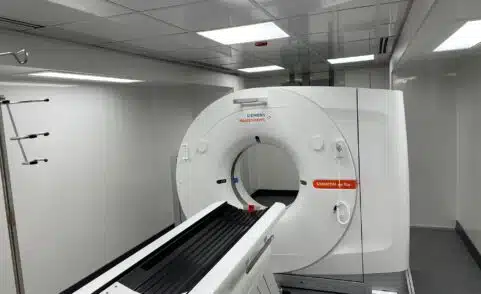
Is it Safe to Get an MRI with my Implant?
After two shoulder replacement surgeries, Sylvia Klees was left with a lot of metal implanted in her body and a challenge when it comes to imaging. Because an MRI is essentially a large magnet, it’s not safe to have any metal near the machine – especially when it’s part of an implant. When Sylvia’s doctor said she needed an MRI, she was turned down twice because of her metal implants before she found RAYUS, where her technologist and radiologist customized her scan to get her the images she needed.
For more on MRI and joint replacements, watch this story.
Thanks to medical advancements and an aging population, more patients than ever have some sort of implant. And while metal in an implant would prevent you from getting an MRI, it’s not always the case. According to Taylor Whitham, an MRI image quality and safety officer at RAYUS, some l implants like neurostimulators, cardiac pacemakers, or cochlear implants that were once unsafe, but now are considered MRI-conditional. “I’d say at least 60-70% or more of implants are now eligible for scans,” says Taylor.
What is MRI-conditional?
“MRI-conditional” means as long as the manufacturer’s specifications are met, it is safe for you to get an MRI. So if you hear the term “MR-safe” or “MRI-safe” it’s technically “MRI-conditional.” In order to find out what those conditions are, our RAYUS experts reache out to the manufacturers, like Medtronic or Boston Scientific, which make the implants. They provide conditions indicating how we need to scan you in order to keep you safe. While we adjust our scans to meet the conditions of every implant patient we can, the manufacturers are constantly adjusting the way they make the implants, too.
“Manufacturers understand that MRI is important and it can save lives,” said Taylor. “So they’re wanting to advance technology to make it more available for those patients that couldn’t get MRI in the past.”
Today, some implantable devices are even made with a setting specific for MRI. The implant can be put into MRI mode to make it safe before the scan begins.
Two keys to keeping you safe
Rest assured that you will be asked about your implant … again and again and again. When you first call to schedule your appointment, we’ll ask if you have an implant. When you arrive for your MRI, you’ll fill out paperwork that asks again. There’s even a diagram of your body where you can mark surgery sites to help jog your memory. And before your scan starts, your technologist will ask you a list of questions including whether or not you have any kind of implant. These steps are designed to help make sure we’re scanning you safely.
Next, we do our research. Once we know you have an implant, we find out everything we can about it. Our technologists are specially trained to research these devices. Sometimes it’s as simple as looking online for the manufacturer’s conditions of your specific model. In more complicated cases, we do further research that may involve bringing in our MRI safety officers to do the legwork. And, in some cases, they may even be on hand for your scan. Once we’ve gathered all the research on your device, we make sure to include that in your chart.
Meeting the conditions of a device can sometimes be complicated, explains Jeff Jahn, vice president of engineering and research at RAYUS. Let’s say you have a pain blocking stimulator for your spine. The manufacturer says you can get a scan on a 1.5T or a 3T MR scanner (the T is for “tesla” — the measurement of the strength of the magnet in the machine). We can meet that condition. But another condition of the device is that it can only be exposed to 1.1 watts per kilogram of RF energy. The MR machine you’re scheduled to be scanned on may only have options for 2 watts or 4 watts. There’s no 1.1 watt setting. That’s when many imaging centers would turn you away. But at RAYUS, our technologists work with our radiologists to modify your exam to meet the manufacturer’s exact conditions.
According to Jeff, “That is the most challenging part of the job because a lot of facilities, in fact the majority of facilities will say, ‘Nope. Can’t scan you. We’re not going to do it.’ Because they don’t know enough of the technology to understand, ‘Yes, I can scan you.’ In fact, the manufacturer has gone to great lengths to test this device to make sure I can scan you safely. But I need to follow these conditions. We’re making our absolute best effort to scan anybody who has an MR-compatible implant, as long as we can meet those conditions.”
How you can help
The most important thing you can do if you have a surgery where something is implanted in your body is this: Keep the Card! Post-op, your surgeon should give you a card with all the details – make and model, serial and lot numbers – of your implant. This card comes from the manufacturer of the device. By simply keeping your card in a safe and handy place, you’ll have it when you need it. With the number of patients she sees with implants, Taylor says she takes this simple step seriously. “I always advise even my family, if you’re having any procedures done, obtain your proper cards from the manufacturer. Take charge of your healthcare and make sure you know what’s happening to you.”
Don’t give up after one “no”
If you need an MRI but get turned down by an imaging center or hospital, don’t give up. Not every imaging facility does the extensive training we do at RAYUS to teach our team how to customize scans for implant patients. We build protocols to meet the criteria of the device and still get you and your doctor high-quality images. Don’t assume you’re not eligible for an MRI based on one “no” … or even more than one.
With her shoulders full of metal, Sylvia was turned down more than once, but she kept looking for an alternative. As she left RAYUS with her shoulder images in hand, she said, “I’m looking forward to what the radiologist, the doctor will diagnose from this MRI. I just want to find out, validate the pain that I’m in, and to see if there’s any corrective issues or even surgery.”
So, don’t give up on imaging with an implant. You can get the answers you need.

